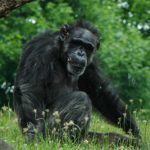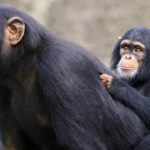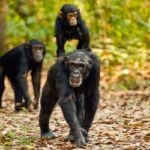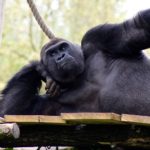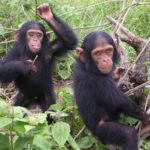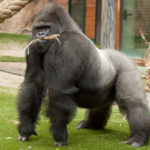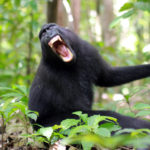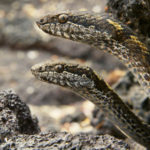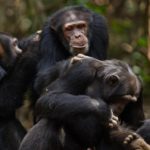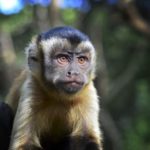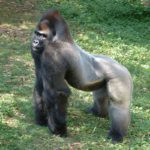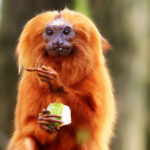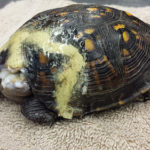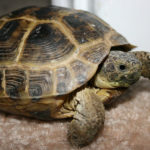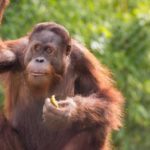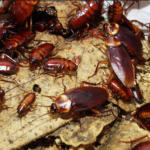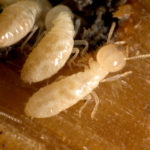Chimpanzees – information
 Chimpanzees at the initial level have abstract concepts and associated emotions. These animals realize the fact of death and really mourn for the lost companion. They are also able to study environmental objects that are not of particular benefit to them, for example, they can consider a creeping python. It is interesting that unlike humans, these monkeys are useless (that is, inedible and non-dangerous) organisms never destroy, on the contrary, there are cases when they fed turtles.
Chimpanzees at the initial level have abstract concepts and associated emotions. These animals realize the fact of death and really mourn for the lost companion. They are also able to study environmental objects that are not of particular benefit to them, for example, they can consider a creeping python. It is interesting that unlike humans, these monkeys are useless (that is, inedible and non-dangerous) organisms never destroy, on the contrary, there are cases when they fed turtles.
However, the altruism of chimpanzees in relation to the surrounding species should not be exaggerated. By nature of feeding these animals are omnivorous. In their diet there are green parts of plants, succulent fruits, grains, honey, eggs of birds, insects and … other monkeys. Ordinary chimps regularly hunt small apes, such as red colobus and monkeys. They surround their victims from all sides, after which several large males climb a tree and kill a monkey. Occasionally they can hunt animals of other kinds: they catch piglets of wild pigs, fish, collect mollusks. Bonobos do not actively hunt, but sometimes they catch monkeys and play with them.
The methods of mining are also diverse. Usually, monkeys slowly walk around the territory, stepping on all four limbs. During walking, their hind legs rest on the ground with the sole, and the front legs with the back of the hand. This careful use of hands is probably due to the great sensitivity of the palms and the important role that they play in manipulating objects. Hard-to-reach food of chimpanzees is extracted with the help of improvised means: an straw is lowered into an anthill, and then the ants sitting on it are dragged out and licked; Pick wood with a stick; Push the object with a stick; Break the shells with a stone. They use leaves as a scoop for water, an umbrella, a fan and … toilet paper.
These monkeys are able to move and on two legs, but in nature, the upright riding is rarely used, mainly during communication in the group. The trees climb well, although they are inferior in this orangutan. Chimpanzees can swim, but do not like to wet without unnecessary necessity. Rain monkeys are patiently tolerated, but on occasion they try to cover their heads with leaves. They sleep for safety only on trees. Typically, for the sleep of chimpanzees, nests of several hastily stacked sticks are built.
There is no pronounced season of reproduction in these primates. The ability of females to conceive offspring occurs cyclically at any time of the year and depends on the age and physical condition of the individual. Pregnancy in chimpanzees lasts 7.5-8 months, the baby is born always one. In the first days of life, he is covered with a rare coat and hides on his mother’s breast, which does not part with him for a second. From adults, young chimpanzees differ in body-pink skin color, with age it darkens and becomes black. Childhood lasts up to 9 years, during this period the female gradually teaches the cubs secrets of survival in nature. Many useful skills kids get by playing with each other and watching other members of the group. Sexual maturity occurs in chimpanzees at 13-14 years, and these monkeys live in natural conditions up to 40-45 years, in zoos up to 55-60 years. Just like people, elderly chimpanzees turn gray.
In nature, the main enemies of these monkeys are leopards. Predators hunt chimps from the ground, stealthily creeping up in the thickets, and then quickly climb the tree and kill the prey. The only remedy for chimpanzees is attentiveness. Seeing the enemy, the monkeys raise a terrible noise, letting the leopard know that they see it – the predator that is found loses interest in the prey and leaves. Chimps accelerate his withdrawal by throwing into a potential offender sticks.
